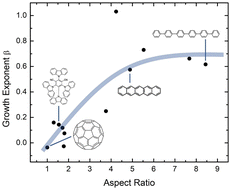A comprehensive picture of roughness evolution in organic crystalline growth: the role of molecular aspect ratio†
Abstract
Exploiting the capabilities of organic semiconductors for applications ranging from light-emitting diodes to photovoltaics to lasers relies on the creation of ordered, smooth layers for optimal charge carrier mobilities and exciton diffusion. This, in turn, creates a demand for organic small molecules that can form smooth thin film crystals via homoepitaxy. We have studied a set of small-molecule organic semiconductors that serve as templates for homoepitaxy. The surface roughness of these materials is measured as a function of adlayer film thickness from which the growth exponent (β) is extracted. Notably, we find that three-dimensional molecules that have low molecular aspect ratios (AR) tend to remain smooth as thickness increases (small β). This is in contrast to planar or rod-like molecules with high AR that quickly roughen (large β). Molecular dynamics simulations find that the Ehrlich–Schwöbel barrier (EES) alone is unable to fully explain this trend. We further investigated the mobility of ad-molecules on the crystalline surface to categorize their diffusion behaviors and the effects of aggregation to account for the different degrees of roughness that we observed. Our results suggest that low AR molecules have low molecular mobility and moderate EES which creates a downward funneling effect leading to smooth crystal growth.

- This article is part of the themed collection: Editor’s Choice collection: Organic Electronics


 Please wait while we load your content...
Please wait while we load your content...